
Window Visible Transmittance Ratings Explained
What if we told you windows could actually improve your health? Before you call us crazy and stop reading, let’s briefly discuss natural sunlight. According to our friends at Healthline↗, exposure to natural light offers a vast array of health benefits – more Vitamin D (for healthy bones), avoidance of seasonal depression, improved sleep and reduced risk of migraines and eye strain.
Best of all, you don’t have to spend hours outside to reap these benefits. By simply sitting next to a window with a high visible transmittance rating, you’re (literally) absorbing all the good stuff your window is allowing to filter through.
So what are window visible transmittance ratings, and how do you know what to look for when upgrading your window game?
What are Visible Light Transmittance Ratings?
When shopping for windows, you may notice a National Fenestration Rating Council (NFRC)↗ label that shows a range of different ratings for things like U-Factor, Solar Heat Gain and Air Leakage. In the bottom left corner of the label under Additional Performance Ratings, you’ll see a 0-1 rating for Visible Transmittance (or VT). This number measures how well the window will light your home with sunlight.
If you’ve ever ordered new windows and noticed after installation that they have an unexpected tint, that’s because they have a lower VT rating and allow less natural light to be filtered through the glass. This scenario happens often, and it’s why understanding visible light transmittance ratings is so important.
Ratings are not only determined by the coating or tint on the glass, but also the thickness of the frame and sash, any grids or muntins the window may have, and the type of glass used.


Understanding Visible Light Transmittance Values
The higher the Visible Transmittance number, the more natural light your window will allow to filter through. A value of 0 means no light is filtered through, while a value of 1 (the highest rating) means maximum light is filtered through. For example, a window with a Transmittance Rating of 0.51 would let in 19% more natural light than a window with a 0.43 rating.
It’s important to note other factors, like the number of panes or the energy efficiency rating, will affect the VT rating. Discuss all of your options free of charge with a Brennan window specialist to ensure you’re getting exactly what you want for the best value. We have more than four decades of experience helping customers find the perfect window for their lifestyle and budget.
Do I want a High or Low Visible Light Transmittance?
This depends on your preference. If your goal is to maximize daylight, you’ll want to search for a higher VT rating. You may think a lower VT rating is best for scorching hot summers, but that’s not necessarily the case anymore. Advancements in window glazing systems allow low-E coatings to reject solar heat while still letting natural light pass through. For more on this topic, read our breakdown of low-E glass in windows.


In Summary…
A higher window visible light transmittance rating will improve the look of “natural light” in your home, while also benefiting your long term health. So choose the rating that’s best for you, and sit by the window while reading a book, watching a movie or simply taking a nap. Your body and mind will thank you.
Brennan Enterprises has helped more than 100,000 Texans improve their homes since 1979. We pride ourselves on providing products and services for every budget and style. Our staff will take care of you long after the initial project. Contact us today for a free estimate.
News, Product Reviews, and Insights
Oops!
We don't currently serve your area but do want to help you plan your project. Try our Build & Price tool to get an idea of window & door costs within DFW. Your area may be higher or lower but at least you'll have some idea of the price.
Thanks for stopping by.




